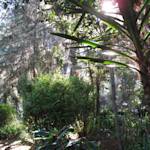Giant kelp
2024 CE • Worldwide
"Kelp are large brown algae (Phaeophyta) that live in cool, relatively shallow waters close to the shore. There are about 30 different species of kelp worldwide. They grow in dense groupings much like a forest on land, and are found predominantly along the Pacific coast from Alaska to parts of Baja California . . . Kelp forests harbor a greater variety and higher diversity of plants and animals than almost any other ocean community. Many organisms use the thick blades as a safe shelter for their young from predators or even rough storms. These underwater towers of kelp provide food, shelter, and protection for all kinds of marine life, including seals, sea lions, sea otters, invertebrates, fish, whales, birds, and more. Kelp forests also provide a variety of ecosystem services to humans and serve as habitat for a number of commercially important fishery species such as kelp bass and black rockfish. Unfortunately, kelp forests today face a variety of threats, such as commercial kelp harvesting, pollution, and climate change, which exacerbates El Niño southern oscillation (ENSO) events and negatively impacts kelp reproduction and survival. Overgrazing by fish and sea urchins is a particularly large problem for kelp forests. Predators such as sea otters and sea stars typically keep populations of urchins and grazing fishes in check; this keeps the numbers of urchins and fish in balance so they don't mow down entire kelp forests. However, recent declines in otters and sea stars on the West Coast have led to an explosion in the number of urchins, which is bad news for kelp forests as they face increased grazing."
"Kelp Forest," National Marine Sanctuaries.
Image: Jenn Caselle / California Sea Grant via Flickr, CC BY 2.0 DEED Attribution 2.0 Generic


Learn about Maya Lin’s fifth and final memorial: a multi-platform science based artwork that presents an ecological history of our world - past, present, and future.

Discover ecological histories and stories of former abundance, loss, and recovery on the map of memory.

Learn how we can reduce our emissions and protect and restore species and habitats – around the world.

See how art can help us rethink the problems we face, and give us hope that each one of us can make a difference.

Help make a global memorial something personal and close to home. Share your stories of the natural world.


